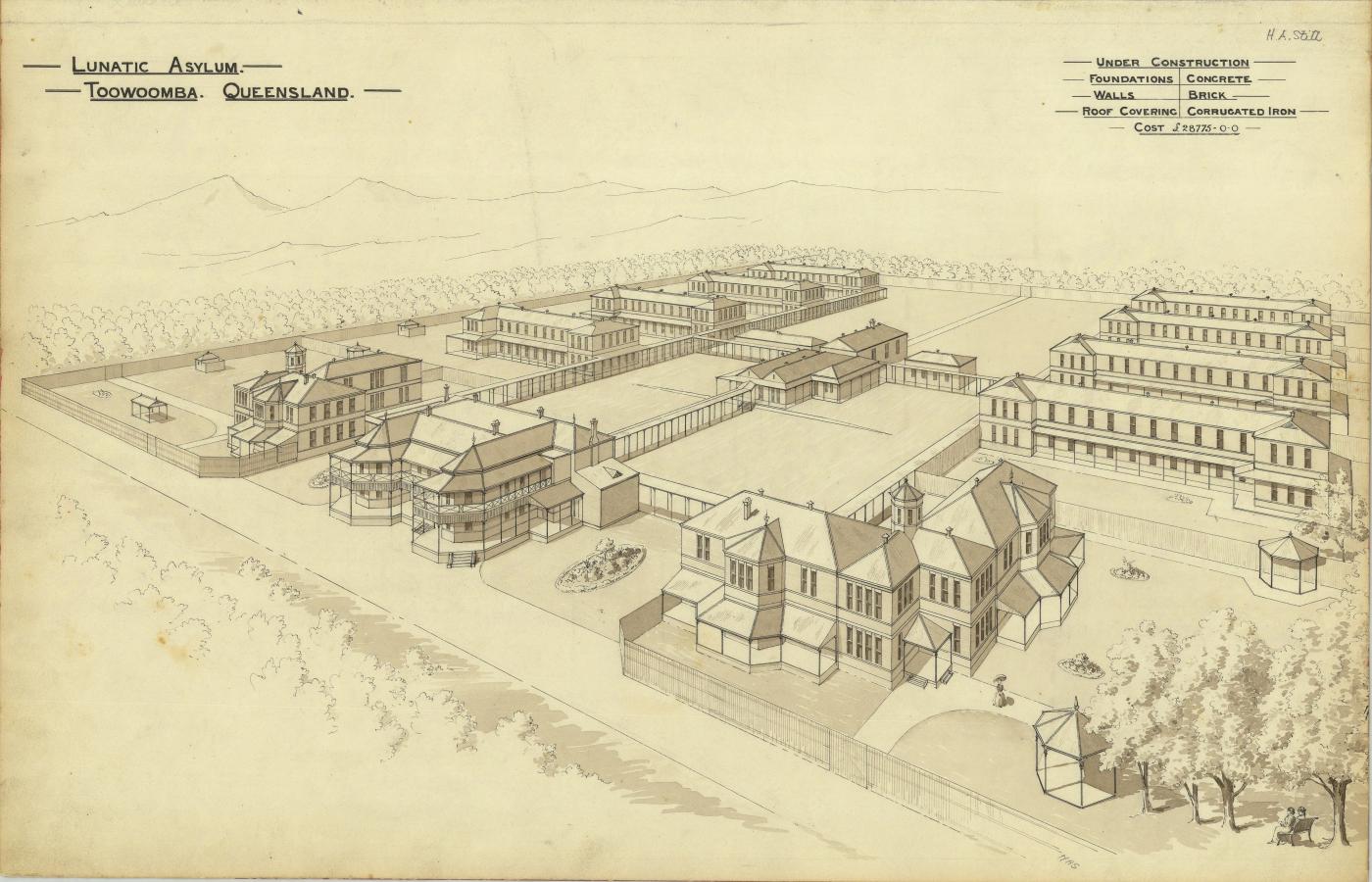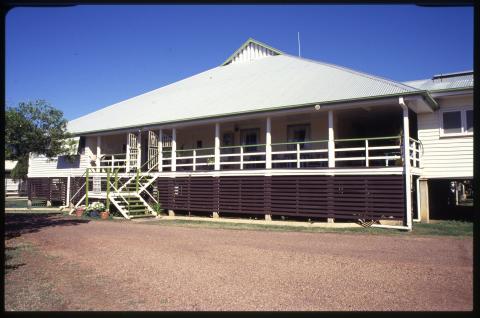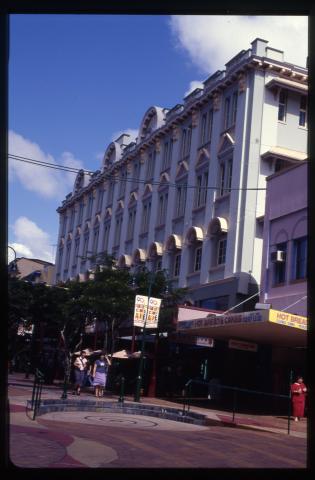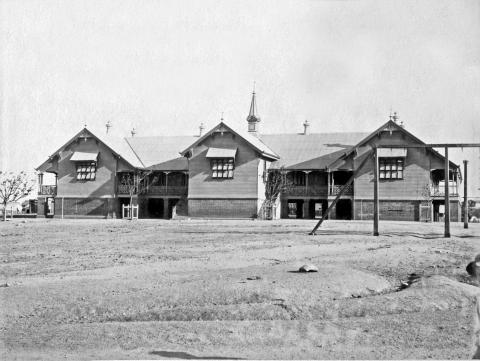
- News of the day
-
Toowoomba Chronicle and Darling Downs General Advertiser, Thursday 22 March 1888, page 3
The New Lunatic Asylum. Progress of the Works.
Material progress is being made with the new Lunatic Asylum works at Toowoomba, by the contractor Mr. James Renwick. These works are of considerable magnitude, for the contract accepted by the Government amounted to £28,775. This was accepted about sixteen months ago, the time for its completion being two years, exclusive of reasonable allowance for delay of work by wet weather. The building is situated in the centre of a paddock of about 98 acres in extent, formerly owned by the Hon. A. C. Gregory. It is on the western side of Gowrie Creek, and by road between three and four miles from the post office at Toowoomba. By rail the distance between the town and the Asylum is considerably shorter. The paddock in which the asylum stands is the boundary of the Western line, and for convenience a siding has been constructed at the foot of the slope leading to the high ground on which the Asylum is in coarse of construction. From the siding to the works a winding road has been made and worn by the carts and drays conveying the material to the works, and no doubt this will be the permanent way from the railroad to the Asylum when it is completed. When it is completed the Asylum will be a quadrangular group of buildings which have already been described in these columns from the plans. Mr. Renwick’s contract, however, comprises the erection of the two convalescent wards on the right and left wings of the front, and a group of central buildings about 50 yards to the rear. These buildings will form the centre block when the asylum is completed according to the original design. Between the convalescent ward and along the front face will be the surgeon superintendent's residence and surgery, but these are not included in Mr. Renwick's contract. Behind the convalescent ward on the left wing is a general ward and that is also in course of construction. The convalescent wards are alike in construction, design, and size.
They are two stories high contain one dormitory on the ground floor measuring 28ft. by 18ft., a dining room 33ft. 6in. by 20ft., attendance rooms, linen closets, lavatories, and sculleries. The upper storey in each ward is partitioned off into sleeping rooms, of good size and thoroughly ventilated. The central group of buildings before referred to will be the offices, the laundry, cooking kitchens, and other conveniences for the whole asylum.
To the left of this is the general ward 150ft. in length but of differing widths. These, then, are the works now in hand and they have progressed so far that the convalescent ward on the right wing is now occupied by the carpenters. Part of the roof is completed, and the woodwork of the remaining part is fixed and ready for the iron. A small octagonal tower rises from the centre of the roof, and that is also ready for its outer covering of zinc and corrugated iron. Inside, the carpenters are busy at flooring and other works. The convalescent ward on the left is still in the hands of the bricklayers who yesterday were building up to about the middle of the windows in the upper story. The general ward to the rear is not so forward, the walls of that being erected as high as the top of the windows on the ground floor. Everything is ready for the bricklayers to proceed with the centre block of buildings, as the concrete, foundations are all completed. It is expected that the convalescent and general wards on the left will be roofed a month hence. The bricklayers will then proceed with the central block of buildings, and it is anticipated that the whole of the contract will be completed within the specified time, and a slight allowance for the bad weather of the past twelve months, when outdoor work has been impossible. The whole of the brickwork is constructed with pressed bricks from Mr. Renwick's Murphy Creek brick yards, and the stone for the facings, window sills, and band coursings, is obtained from the Murphy’s Creek and Highfields quarries. Lying on the ground is sufficient freestone, nearly all of which is worked, to complete the contract, and the total number of bricks for the same purpose are now made and awaiting burning at Murphy's Creek. The whole of the work now, and for some time past has been under the supervision of Government Inspector Corney, who passes all material used in the contracts. Occasionally visits to the works have been made by Dr. Scholes, the Surgeon Superintendent of Woogaroo and Inspector of Asylums and Reception Houses for the colony, and by Mr. Connolly, the Colonial Architect, both of whom have expressed their entire satisfaction at the progress of the works.
- Background
-
Baillie Henderson Hospital is situated on the northwestern outskirts of Toowoomba. It was established as a lunatic asylum in 1890 and continues to provide psychiatric care with more than 400 patients and is the most intact nineteenth century asylum in Queensland.
Queensland's first asylum was opened at Woogaroo in 1865. Within a decade overcrowding was a chronic problem and a Royal Commission in 1877 recommended the establishment of asylums at Toowoomba and Rockhampton. An asylum was established at Sandy Gallop (the Challinor Centre at Ipswich) in 1878 and operated as an annexe of Goodna until 1910 when it became a separate institution. The Rockhampton asylum did not proceed and plans for the Toowoomba institution were prepared by the colonial architect JJ Clark in 1885. These plans provided for a large complex with two rows of pavilion wards separated by service buildings.
The design and planning of the Toowoomba asylum was based on the principles of asylum design as enunciated by J Conolly in The Construction and Government of Lunatic Asylums and the original plan took more than 20 years to complete.
The power of symmetrical form with its inherent qualities of balance and order were used to great effect at the Toowoomba asylum in its master planning and building design. The site was laid out about an east-west axis on which service and ancillary buildings were centred with identical pairs of pavilion wards, males to the south and females to the north laid equidistant from the centre and from each other. The wards and service buildings were also of symmetrical design reinforced and connected by a continuous covered walkway. Each of the ward buildings had an associated outdoor area enclosed by a three metre high close boarded timber fence into which, shelter sheds and gates were set. The requisite requirements for a pleasant environment were enhanced by landscaping which including planting of gardens and perimeter trees to create vistas and more intimate areas for repose.
Construction commenced in 1886 and by 1890 sufficient building has been completed for the asylum to open. In 1891, the Toowoomba Lunatic Asylum comprised a male (Jofre House) and female (Ray House) convalescent ward, a general female ward (Pinel House), and a group of buildings comprising the administration building (now MacDonald Hall), kitchen, bathrooms, washhouse and store and the medical superintendent's residence which was situated adjacent to Hogg Street away from the main complex. The first patients were transferred from the Goodna asylum and by the end of 1890, the number of patients totalled 196. The second male ward (Ward B - Rush House), Pinel House's complement, was completed in 1892.
Construction continued throughout the 1890s and 1900s with additional pairs of male and female pavilion wards constructed in 1898 (Male Ward C and Female Ward 3) and 1902 (Male Ward D- Clouston House and Female Ward 4[now the Museum]), the assistant medical superintendent's residence (1899), nurses' quarters (1909) and administration block (1910). By 1910 the original plan was complete and the asylum accommodated more than 700 patients.
A second major building phase occurred in the period 1915-1919. In 1909 Dr HB Ellerton, an English trained medical practitioner was appointed Inspector of Hospitals for the Insane in Queensland. On his appointment, Ellerton immediately set about implementing changes and improvements to the asylums and re-ception houses in the state. Apart from numerous administrative changes, Eller-ton oversaw a major upgrading and expansion of the infrastruc-ture at Goodna, Ipswich and Toowoomba asylums.
At Toowoomba, five new buildings were erected as a result of Ellerton's initiatives. Ellerton was a strong advocate of the 'moral treatment' approach to insanity. This approach stressed the need for providing a pleasant environment for patients and useful employment and recreation. This philosophy was evident in a pair of new large blocks erected in 1917-1919 Female Ward 5 (Whishaw House) and Male Ward E (Browne House) set within landscaped grounds with views to the surrounding countryside. Also in this period, a pair of domestic scale wards (Male Admission Ward - James House and Female Admission Ward - Hill House) and a hospital ward (Tredgold House) were completed. These buildings faced a recreation ground centred on the east west axis of the original hospital plan. Throughout this period agriculture was important part of the asylum operations, partly to offset costs and also to provide employment for patients.
Few major building projects were undertaken in the subsequent decades. Improvements were limited to extensions to the nurses quarters (1934), new bathrooms, staff residences and laundrettes. The name of the institution was changed to the 'Toowoomba Mental Hospital' following the Mental Hygiene Act of 1938. This Act signalled a number of changes in the administration of mental health and coincided with new approaches to treatment, particular the use of drug therapies. A further name change to 'Toowoomba Special Hospital' followed the Mental Health Act of 1962. In August 1968 it was renamed 'Baillie Henderson Hospital' in honour of Dr John Hector Baillie Henderson (1902-1981), Assistant Medical Superintendent 1939-1950 and Medical Superintendent 1950-1969.
Following decades of only minor building works, a major program of upgrading and replacing existing facilities commenced in the mid 1960s. New service buildings included laundry (1968), canteen (1968), kitchen (1972) and artisan's block (1980). New wards and accommodation facilities included Conolly, Tuke and Digby (1974), Penrose and Maudsley (1977), and Gowrie Hall complex (1991). Most of these buildings were erected to the north and west of the existing complex. Male Ward C and Female Ward 3(1898) and the kitchen and laundry were amongst the original buildings demolished c1971 as part of this building program. The Recreation Complex located west of McDonald Hall was constructed during this later building program.
Courtesy of the Queensland Heritage Register



